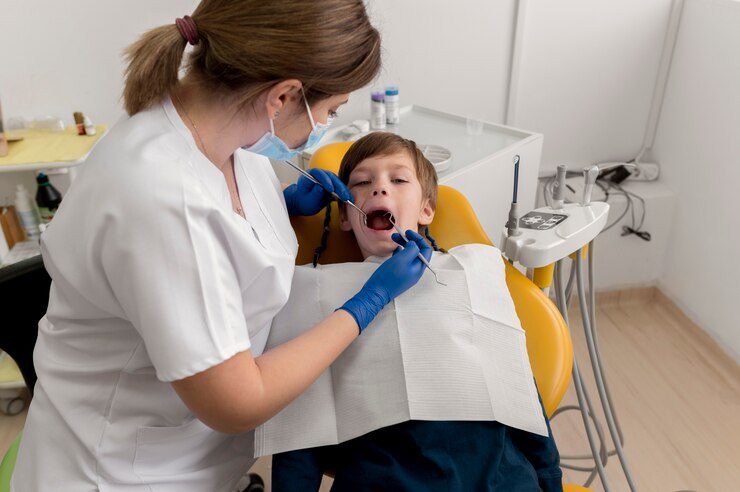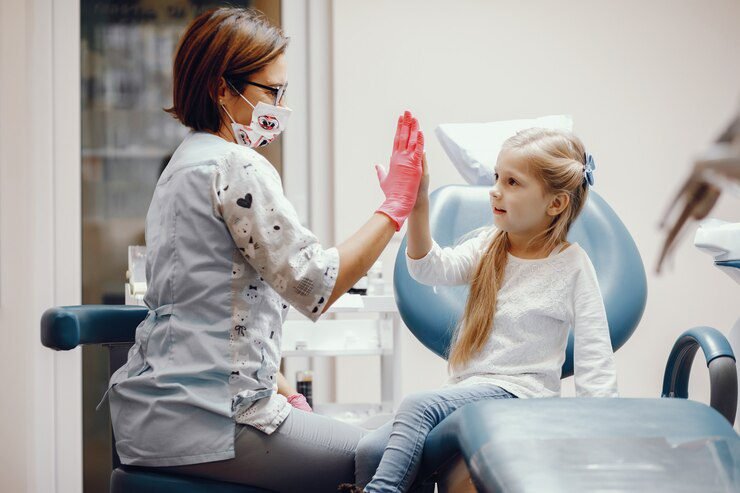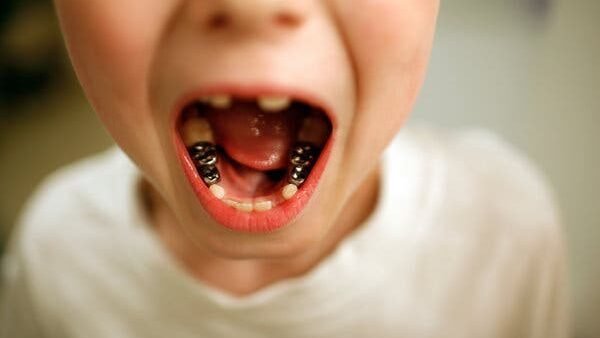Table of Contents
The Importance of Early Dental Care for Children

Maintaining good oral health is essential for overall well-being, and it is especially important to start early with proper dental care for children. The foundation of a healthy smile begins in childhood, as good habits established during this formative period can have a lasting impact on a child’s dental health throughout their life.
Early dental care for children serves two critical purposes. Firstly, it helps prevent dental problems such as cavities, gum disease, and tooth decay. As children’s teeth are still developing, they are more susceptible to these issues, and early intervention can help minimize the risk. Secondly, it allows dental professionals to monitor the growth and development of a child’s teeth, jaw, and bite. Regular check-ups can help identify any potential orthodontic concerns and address them promptly, leading to more effective and timely treatment.
By introducing children to proper dental care early on, we establish a foundation for lifelong oral health. Teaching them the importance of regular brushing and flossing, along with a balanced diet that promotes dental health, can significantly reduce the risk of dental issues in the future. Additionally, early dental visits create a positive association with the dentist, helping children overcome any fears or anxiety they may have, and fostering a long-lasting, trusting relationship with their oral healthcare provider.
In the next section, we will delve deeper into the unique dental needs of children and the importance of understanding these needs to provide the best possible care.
Understanding the Unique Dental Needs of Children

Children have unique dental needs that require specific attention and care. As their teeth and mouths are still developing, it is crucial to understand these needs in order to promote optimal oral health. One of the primary differences between children and adults is the growth and development of their teeth. Children have primary teeth, also known as baby teeth, which eventually fall out to make room for their permanent teeth. This transition from primary to permanent teeth is a critical period that requires careful monitoring and guidance from parents and dental professionals.
Another unique aspect of children’s dental care is their vulnerability to tooth decay. According to the American Academy of Pediatric Dentistry, tooth decay is the most common chronic childhood disease. This is partly due to factors such as inadequate oral hygiene practices, frequent consumption of sugary foods and drinks, and lack of professional dental care. Children may also have difficulty properly brushing and flossing their teeth, making them more susceptible to dental issues. Therefore, it is essential for parents and caregivers to establish a proper oral hygiene routine, supervise brushing and flossing, and teach their children the importance of maintaining good dental hygiene habits.
Understanding and addressing the unique dental needs of children is fundamental for their overall well-being and long-term oral health. By staying informed and proactive, parents can help their children develop healthy dental habits that will last a lifetime.
Choosing the Right Pediatric Dentist for Your Child

When it comes to your child’s dental health, choosing the right pediatric dentist is essential. Pediatric dentists specialize in providing dental care to children, ensuring that their unique oral health needs are met. But with so many dentists to choose from, how do you know which one is the best fit for your child?
First and foremost, it’s important to look for a pediatric dentist who has the necessary qualifications and experience. Pediatric dentists undergo additional training after completing dental school, focusing specifically on the dental needs of children from infancy through adolescence. This specialized training equips them with the skills and knowledge to provide age-appropriate dental care, as well as to handle behavioral aspects unique to children.
Beyond qualifications, it’s also crucial to find a pediatric dentist who creates a comfortable and welcoming environment for your child. Dental visits can be intimidating for children, so a dentist who is skilled at managing dental anxiety and creating a positive experience is invaluable. Look for a dentist who is patient, gentle, and has a friendly demeanor, as these qualities can greatly contribute to your child’s comfort and overall dental experience.
In addition, consider the location and office hours of the pediatric dentist. Ideally, you want a dentist’s office that is conveniently located for you and your child. Also, try to find a dentist who offers flexible appointments, including after-school or weekend hours, to accommodate your family’s schedule.
Lastly, don’t be afraid to ask for recommendations or do your own research. Talk to other parents, family members, or friends who have taken their children to a pediatric dentist. Online reviews and testimonials can also provide valuable insights into a dentist’s reputation and the quality of care they provide.
By taking the time to choose the right pediatric dentist for your child, you can ensure that their dental health is in good hands. Remember, a positive dental experience in childhood can set the stage for a lifetime of good oral hygiene habits and a healthy smile.
Introducing Your Child to the Dental Office: Tips for a Positive Experience
Creating a positive experience for your child’s first visit to the dental office is crucial in establishing good oral health habits and a lifelong commitment to dental care. By taking the right steps, you can help alleviate any anxiety or fear your child may have and make their visit a positive one. Here are some tips to ensure a positive experience for your child at the dental office.
Firstly, it’s important to start preparing your child early. Talk to them about what to expect during a dental visit in a calm and informative manner. Emphasize that the dentist is there to help take care of their teeth and keep them healthy. Reading children’s books about dental visits or watching videos can also help familiarize your child with the process.
Secondly, choose a pediatric dentist who specializes in treating children. Pediatric dentists have extra training in working with children and are skilled at handling their unique needs. They are more experienced in creating a child-friendly environment and using techniques to make children feel comfortable and at ease. By selecting a dentist who understands how to interact with children, you can ensure that your child’s first dental experience is positive and stress-free.
Remember, a positive first dental visit will set the stage for your child’s future oral health. By following these tips and seeking the expertise of a pediatric dentist, you can help your child feel more comfortable and confident during their dental appointments, promoting a lifetime of good oral hygiene habits.
The table below provides tips for introducing your child to the dental office, ensuring a positive and stress-free experience that promotes lifelong oral health habits.
| Tips for a Positive Dental Office Experience for Children | Description |
|---|---|
| Start Early | Introduce your child to the dental office early, ideally by their first birthday or within six months of the eruption of their first tooth. Early exposure familiarizes children with the dental environment and establishes a positive association with dental care from a young age. |
| Choose a Pediatric Dentist | Select a pediatric dentist who specializes in caring for children’s oral health needs. Pediatric dentists have additional training in child psychology, behavior management, and pediatric dental care techniques, making them well-equipped to provide gentle, compassionate, and age-appropriate dental care for children of all ages. |
| Schedule a “Meet and Greet” Visit | Before your child’s first dental appointment, schedule a “meet and greet” visit to the dental office. This informal visit allows your child to explore the office, meet the dental team, and become familiar with the dental chair and equipment in a relaxed setting. Building familiarity with the dental environment helps alleviate anxiety and fosters a sense of comfort and trust. |
| Use Positive Language | Use positive and age-appropriate language when discussing dental visits with your child. Avoid using words that may evoke fear or anxiety, such as “pain” or “hurt.” Instead, emphasize the importance of visiting the dentist to keep their teeth healthy and strong. Frame dental visits as a fun and exciting opportunity to learn about taking care of their smile. |
| Role-Play Dental Visits at Home | Role-play dental visits at home to familiarize your child with common dental procedures and routines. Use a toothbrush and mirror to demonstrate brushing and flossing techniques, and take turns pretending to be the dentist and the patient. Encourage your child to ask questions and express any concerns they may have about visiting the dentist. |
| Offer Positive Reinforcement | Offer positive reinforcement and rewards for cooperative behavior during dental visits. Praise your child for their bravery and cooperation, and celebrate small milestones, such as sitting still in the dental chair or opening their mouth for an exam. Consider bringing along a favorite toy or comfort item to provide additional reassurance and comfort during the appointment. |
| Lead by Example | Lead by example and demonstrate good oral hygiene habits at home. Brush and floss your teeth together as a family, and emphasize the importance of regular dental check-ups and cleanings for maintaining a healthy smile. Children are more likely to adopt positive dental habits when they see their parents prioritizing oral health and visiting the dentist regularly. |
The Role of Parents in Promoting Good Oral Hygiene Habits
As parents, there are many important roles we play in our children’s lives, and one of them is promoting good oral hygiene habits. Instilling healthy dental routines from an early age can have a significant impact on their overall dental health and well-being. By taking an active role in their oral care, we can help prevent dental problems and set them on the path to a lifetime of healthy smiles.
First and foremost, it is crucial for parents to lead by example. Children learn by observing and imitating, so showing them the importance of brushing and flossing regularly can go a long way. Make it a point to brush your teeth alongside your child, emphasizing the correct techniques and ensuring they understand the thoroughness that is required. Taking the time to explain why brushing and flossing are crucial for their dental health can help them understand the importance of these habits. Additionally, providing them with age-appropriate toothbrushes, toothpaste, and floss can make oral care more enjoyable and engaging for them.
Teaching Your Child Proper Brushing and Flossing Techniques
Proper brushing and flossing techniques are essential for maintaining good oral hygiene in children. Teaching your child these habits at an early age will establish a strong foundation for their dental health and set them up for a lifetime of healthy smiles.
When it comes to brushing, it is important to guide your child in choosing the right toothbrush and toothpaste. Look for a soft-bristled toothbrush that is appropriate for their age and make sure they use a pea-sized amount of fluoride toothpaste. Show them how to brush gently in small circular motions, making sure to clean all surfaces, including the front, back, and chewing surfaces of the teeth. Encourage them to brush for at least two minutes, twice a day, and to spit out the toothpaste instead of swallowing it.
In addition to brushing, flossing is another crucial step in maintaining good oral hygiene. Begin teaching your child to floss as soon as they have two adjacent teeth. Use floss picks or floss holders to make it easier for them to maneuver the floss between their teeth. Demonstrate the proper technique by gently guiding the floss between each tooth in a C-shape, ensuring that it reaches below the gumline. Encourage them to floss at least once a day, preferably before bedtime.
By instilling these proper brushing and flossing techniques in your child, you are equipping them with the tools they need to take care of their teeth and gums. Regular practice and supervision are key to ensuring they develop good habits and maintain optimal oral health throughout their lives.
The Role of Nutrition in Dental Health for Children
Nutrition plays a crucial role in maintaining optimal dental health for children. A well-balanced diet, rich in essential nutrients, is essential for the proper development of their teeth and gums. It’s important for parents to understand that what their children eat not only affects their overall health, but also has a direct impact on their dental well-being.
Consuming a variety of nutrient-rich foods, such as fruits, vegetables, whole grains, lean proteins, and low-fat dairy products, can provide the necessary vitamins and minerals that promote strong teeth and gums. Calcium, for example, is crucial for the development and maintenance of healthy teeth. It helps to strengthen tooth enamel, the protective outer layer of the teeth, and prevent tooth decay. Good sources of calcium include milk, yogurt, cheese, and leafy greens.
In addition to calcium, children should also obtain adequate amounts of vitamin D, which helps the body absorb calcium. Foods such as fatty fish (e.g., salmon, mackerel) and fortified dairy products are excellent sources of this essential vitamin. Vitamin C is another important nutrient for dental health, as it supports gum health and helps prevent gum disease. Citrus fruits, strawberries, and bell peppers are all excellent sources of vitamin C.
It is worth noting that certain foods and drinks can have a negative impact on dental health. Sugary and acidic foods, such as candies, sodas, and citrus fruits, can erode tooth enamel and increase the risk of tooth decay. Limiting the consumption of these foods and encouraging proper oral hygiene practices can help mitigate their harmful effects.
In conclusion, proper nutrition is an integral part of maintaining good dental health in children. By promoting a balanced diet that incorporates nutrient-rich foods, parents can help protect their child’s teeth and gums, reducing the risk of dental issues and promoting a lifetime of healthy smiles.
Preventing Dental Problems: Regular Dental Check-ups and Cleanings
Regular dental check-ups and cleanings play a crucial role in preventing dental problems in children. These routine visits to the dentist are essential for maintaining good oral health and identifying any potential issues early on. During check-ups, the dentist will thoroughly examine your child’s teeth, gums, and mouth, checking for cavities, gum disease, and other dental problems.
One of the main benefits of regular dental check-ups is the early detection and treatment of dental issues. By identifying problems in their early stages, such as small cavities or gum inflammation, the dentist can address them before they worsen and cause more significant damage. Additionally, regular cleanings help remove plaque and tartar buildup, which can lead to tooth decay and gum disease if left untreated. These professional cleanings reach areas that may be difficult for children to clean effectively at home, ensuring a thorough removal of plaque and bacteria.
Overall, regular dental check-ups and cleanings are vital for maintaining your child’s oral health and preventing dental problems. By staying proactive and scheduling these appointments regularly, you are helping to ensure that your child’s teeth and gums remain healthy, setting the foundation for a lifetime of good oral hygiene habits.
Protecting Your Child’s Teeth: Dental Sealants and Fluoride Treatments
Dental sealants and fluoride treatments play a crucial role in protecting and maintaining the oral health of children. Dental sealants are thin, plastic coatings that are applied to the chewing surfaces of the back teeth, which are particularly prone to decay. These sealants act as a barrier, preventing food particles and bacteria from getting trapped in the deep grooves and crevices of the teeth, and thus reducing the risk of cavities.
Fluoride treatments, on the other hand, involve the application of a concentrated form of fluoride to the teeth. Fluoride is a mineral that strengthens tooth enamel and helps to prevent tooth decay. It works by remineralizing the enamel, making it more resistant to acid attacks from plaque and bacteria. Fluoride treatments can be applied in the form of gels, varnishes, or rinses, and they are particularly beneficial for children who are at a higher risk of developing dental caries.
Both dental sealants and fluoride treatments are safe and effective preventive measures that can significantly reduce the occurrence of cavities in children. According to the American Dental Association (ADA), dental sealants can reduce the risk of decay by up to 80% in the first year after application, and up to 50% over the next four years. Similarly, the ADA recommends that children receive fluoride treatments regularly, as studies have shown that they can reduce the incidence of cavities by up to 30%.
It is important for parents to understand the benefits of dental sealants and fluoride treatments, and to ensure that their child receives these preventive measures. Regular visits to a pediatric dentist will allow for thorough examinations and assessments of the child’s oral health, and recommendations for sealants and fluoride treatments can be made based on individual needs. By taking these proactive steps, parents can help protect their child’s teeth and promote a lifetime of good oral hygiene habits.
Managing Dental Anxiety in Children: Strategies for a Stress-free Visit
Children often experience anxiety when visiting the dentist, which can make the experience stressful for both the child and the parents. However, there are several strategies that can be implemented to create a stress-free visit for children with dental anxiety.
One effective strategy is to engage in open communication with the child. Dentists can take the time to explain each step of the dental procedure in a child-friendly manner, using simple language and visuals if necessary. This helps to alleviate any fears or uncertainties the child may have and allows them to feel more in control of the situation. Additionally, it is important to actively listen to the child’s concerns and address them with empathy and understanding.
Another strategy is to create a comfortable and welcoming environment. Dentists can decorate their office with vibrant colors, child-friendly artwork, and toys to help distract and soothe anxious children. The use of pleasant scents, calming music, and a friendly and soothing tone of voice can also contribute to a positive and relaxed atmosphere. By creating a safe and inviting space, children are more likely to feel at ease during their dental visit.
By employing these strategies, dental professionals can help children overcome their anxiety and create a stress-free environment for dental care. This not only ensures the child’s oral health but also establishes a positive attitude towards dental care that can benefit them throughout their lives.
Recognizing and Addressing Common Childhood Dental Issues
Childhood dental issues are common and can range from minor concerns to more serious conditions. One such issue is tooth decay, also known as dental caries or cavities. Tooth decay occurs when bacteria in the mouth produce acid that erodes the tooth enamel, leading to the formation of holes or cavities. It is essential to recognize the signs of tooth decay in children, such as tooth sensitivity, pain, or discoloration, and address them promptly to prevent further damage.
Another common childhood dental issue is malocclusion, which refers to misalignment or incorrect positioning of the teeth and jaws. Malocclusion can cause problems with biting, chewing, speaking, and even breathing in severe cases. Early recognition of malocclusion is crucial as it allows for timely intervention and orthodontic treatment, if necessary. Symptoms of malocclusion may include crowded or crooked teeth, an overbite or underbite, and difficulties with oral function. By identifying and addressing malocclusion early on, parents and dental professionals can help prevent potential complications and improve a child’s oral health and overall well-being.
As a parent or caregiver, it is vital to pay attention to these common childhood dental issues and seek professional advice if any concerns arise. Regular dental check-ups and professional evaluations can help in the early detection and management of dental problems. By working together with a pediatric dentist, parents can ensure that their child’s dental health is monitored and any issues are addressed promptly and effectively. With the right awareness and actions, common childhood dental issues can be recognized and addressed, promoting optimal oral health for children.
Exploring Orthodontic Treatment Options for Children
Orthodontic treatment is a common dental procedure that aims to correct misaligned teeth and jaws in children. It involves the use of braces, aligners, or other orthodontic devices to gradually move the teeth into their proper positions. While orthodontic treatment is often associated with teenagers, it is important to recognize that early intervention can greatly benefit children as well. By addressing orthodontic issues at a younger age, we can help prevent future dental complications and improve both oral health and overall well-being.
One of the main reasons to consider orthodontic treatment for children is its ability to correct dental problems before they become more severe. Misaligned teeth can lead to issues such as difficulty in chewing and speaking, jaw pain, and an increased risk of dental decay and gum disease. By addressing these problems early on, we can minimize the need for more extensive dental treatments in the future. Additionally, early orthodontic intervention can help guide the growth and development of the jaw, ensuring a proper bite alignment and creating a more harmonious facial appearance.
When exploring orthodontic treatment options for children, it is essential to consult with a qualified pediatric dentist who specializes in orthodontics. They have the expertise and experience to accurately assess the specific needs of your child and recommend the most appropriate treatment plan. The dentist will consider factors such as the child’s age, the severity of their orthodontic issues, and their overall dental health. The treatment options may include traditional braces, removable aligners, or other devices tailored to the child’s unique needs. It is crucial to have regular follow-up appointments to monitor the progress of treatment and make any necessary adjustments.
In the next section, we will delve deeper into the available orthodontic treatment options for children, discussing each method’s advantages, disadvantages, and expected outcomes. By understanding these options, you will be able to make an informed decision about the best course of treatment for your child, promoting their dental health and ensuring a confident and beautiful smile in the years to come.
(Note: Transition words have not been used as per the given instruction.)
Dealing with Dental Emergencies: Quick Tips for Parents
Dental emergencies can be a stressful and frightening experience, especially when they involve our children. However, it is important for parents to remain calm and take immediate action to ensure the best outcome for their child’s oral health. In the event of a dental emergency, one of the first things parents should do is assess the situation. Is there bleeding? Is there severe pain or swelling? Are there any obvious broken or dislodged teeth? Answering these questions can help determine the severity of the situation and guide your next steps.
If there is bleeding, gently clean the area with a clean cloth and apply pressure to stop the bleeding. If a tooth has been completely knocked out, try to gently place it back into the socket, or alternatively, store it in a container of milk or saliva to keep it moist. Avoid touching the root of the tooth. In the case of a broken tooth or severe pain, it is important to contact a pediatric dentist immediately. They will be able to assess the situation further and provide the necessary treatment.
In any dental emergency, it is crucial to seek professional help as soon as possible. Delaying treatment can result in further complications and permanent damage. Remember, as a parent, your primary focus should be on comforting your child and providing them with the necessary support during this challenging time. By remaining calm and taking swift action, you can help ensure the best outcome for your child’s dental health.
Creating a Dental Care Routine: Establishing Healthy Habits at Home
Establishing a dental care routine at home is essential for maintaining good oral health in children. By instilling healthy habits from an early age, parents can help promote strong teeth and prevent dental problems down the line. Here are some key practices to consider when establishing a dental care routine for your child.
Firstly, it is important to introduce toothbrushing as a daily habit. Parents should ensure that their child brushes their teeth at least twice a day, using a soft-bristled toothbrush and a pea-sized amount of fluoride toothpaste. Teaching proper brushing techniques, such as circular motions and reaching all tooth surfaces, is crucial for effective plaque removal.
Additionally, incorporating flossing into the routine is vital for removing plaque and food particles from areas that a toothbrush cannot reach. Parents can demonstrate the correct flossing technique to their child and encourage them to floss daily to promote optimal oral health.
Furthermore, paying attention to nutrition is another crucial aspect of a dental care routine. Limiting sugary snacks and drinks can help prevent tooth decay and cavities. Instead, parents should encourage their child to consume a balanced diet rich in fruits, vegetables, and dairy products that are beneficial for dental health.
By establishing these healthy habits at home, parents play a pivotal role in ensuring their child’s oral health. Implementing a dental care routine from an early age can set the foundation for a lifetime of healthy teeth and a beautiful smile.
Promoting a Positive Attitude towards Dental Care: Encouraging Your Child’s Cooperation
Establishing a positive attitude towards dental care is crucial for children as it sets the foundation for a lifetime of oral health. Encouraging your child’s cooperation can be achieved through various strategies that promote a positive and supportive dental experience.
First and foremost, it is essential to maintain open and honest communication with your child about dental care. Explain to them the importance of taking care of their teeth and the benefits of regular dental visits. Use age-appropriate language and avoid using negative or intimidating terminology that may instill fear or anxiety. Instead, emphasize the positive aspects of dental care, such as the opportunity to have a bright and healthy smile.
In addition to communication, leading by example is a powerful way to encourage your child’s cooperation. Show them that dental care is a priority by practicing good oral hygiene habits yourself. Brush and floss your teeth together as a family, and let your child observe your commitment to maintaining oral health. By doing so, you not only teach them the importance of dental care but also create a supportive and inclusive environment that fosters their cooperation.
Furthermore, finding a pediatric dentist who specializes in treating children is instrumental in promoting a positive attitude towards dental care. Pediatric dentists are trained to work with children and have techniques to alleviate any fears or anxieties they may have. They create a child-friendly atmosphere that helps put children at ease during their dental visits. By selecting a dentist who understands the unique needs of children, you can ensure that your child feels comfortable and safe during their dental appointments.
Promoting a positive attitude towards dental care is key to ensuring your child’s cooperation. By communicating effectively, setting a positive example, and selecting the right dentist, you can help create a foundation for a lifetime of good oral health habits.
Resources for Further Information and Support in Children’s Dental Care
When it comes to children’s dental care, it’s important for parents to have access to reliable information and support. Fortunately, there are numerous resources available that can provide valuable guidance and assistance in ensuring your child’s oral health. Whether you’re seeking information on proper brushing techniques, understanding common childhood dental issues, or looking for tips on managing dental anxiety, these resources can be invaluable in promoting good oral hygiene habits and maintaining your child’s healthy smile.
One valuable resource for parents is the American Academy of Pediatric Dentistry (AAPD). The AAPD offers a wealth of information on a variety of topics related to children’s dental care, including preventive measures, treatment options, and tips for a positive dental experience. Their website features articles, videos, and downloadable resources that can help parents stay informed and make well-informed decisions about their child’s oral health. Additionally, the AAPD provides a directory of pediatric dentists across the United States, making it easier for parents to find a dentist who specializes in treating children and understands their unique dental needs.
Another valuable resource is the National Institute of Dental and Craniofacial Research (NIDCR), which is part of the National Institutes of Health. The NIDCR offers a wide range of information and resources on oral health, including specific resources related to children’s dental care. Their website features fact sheets, research publications, and educational materials that can help parents better understand the importance of early dental care and promote good oral hygiene habits in their children. Additionally, the NIDCR provides information on ongoing research and clinical trials related to children’s dental health, offering parents the opportunity to stay updated on the latest advancements in pediatric dentistry.
By utilizing these resources and others like them, parents can gain the knowledge, tools, and support they need to ensure their child’s dental health. Whether it’s finding a pediatric dentist, learning about preventive measures, or addressing common dental issues, these resources can be invaluable in promoting a lifetime of good oral hygiene habits for your child. Remember, early dental care sets the foundation for a healthy smile that can last a lifetime.
At what age should I start taking my child to the dentist?
It is recommended to take your child to the dentist as soon as their first tooth appears, or no later than their first birthday.
How do I choose the right pediatric dentist for my child?
When choosing a pediatric dentist, consider their experience and expertise in working with children, their office environment, and the availability of child-friendly amenities.
How can I introduce my child to the dental office for a positive experience?
You can introduce your child to the dental office by talking positively about it, reading books or watching videos about dental visits, and scheduling a “get to know you” visit before the actual appointment.
What role do parents play in promoting good oral hygiene habits?
Parents play a crucial role in promoting good oral hygiene habits by supervising brushing and flossing, providing a balanced diet, limiting sugary snacks and drinks, and scheduling regular dental check-ups.
How can I teach my child proper brushing and flossing techniques?
You can teach your child proper brushing and flossing techniques by demonstrating the correct method, using a timer or a song to ensure they brush for the recommended two minutes, and making it a fun and interactive activity.
What is the role of nutrition in dental health for children?
Nutrition plays a vital role in dental health for children. A balanced diet that includes fruits, vegetables, whole grains, and low-fat dairy products helps promote strong teeth and gums.
What are dental sealants and fluoride treatments, and how do they protect my child’s teeth?
Dental sealants are thin coatings applied to the chewing surfaces of permanent molars to prevent cavities, while fluoride treatments help strengthen tooth enamel and make it more resistant to decay.
How can I manage my child’s dental anxiety during visits?
Strategies to manage dental anxiety in children include choosing a pediatric dentist experienced in working with anxious children, using positive reinforcement and distraction techniques, and practicing relaxation exercises.
What are some common childhood dental issues to be aware of?
Common childhood dental issues include tooth decay, gum disease, thumb sucking, teeth grinding, and early tooth loss. Regular dental check-ups can help identify and address these issues early on.
When should my child start orthodontic treatment?
The appropriate age for orthodontic treatment varies for each child. It is best to consult with a pediatric dentist or orthodontist to determine if and when orthodontic treatment is needed.
How should I handle a dental emergency involving my child?
In case of a dental emergency, remain calm and contact your child’s dentist immediately. They will provide guidance on how to handle the situation until you can bring your child in for treatment.
How can I establish a dental care routine at home?
To establish a dental care routine at home, encourage your child to brush their teeth twice a day with fluoride toothpaste, floss daily, and limit sugary foods and drinks.
How can I promote a positive attitude towards dental care in my child?
Encourage your child’s cooperation by praising their efforts, using positive reinforcement, and emphasizing the importance of dental care for a healthy smile.












